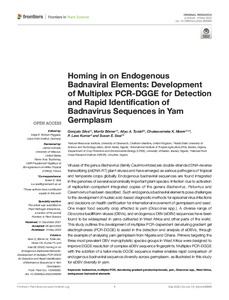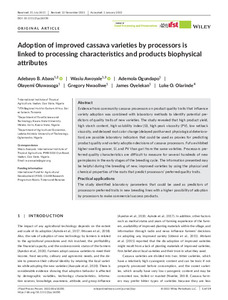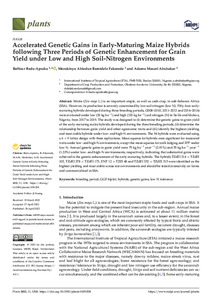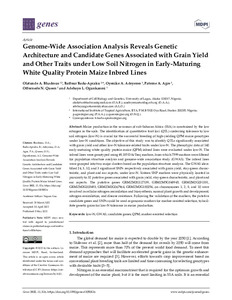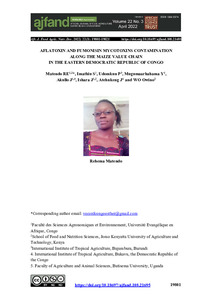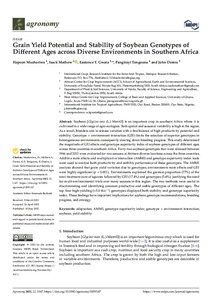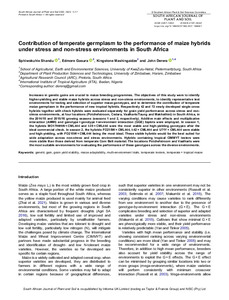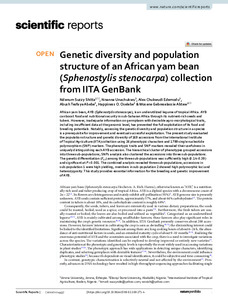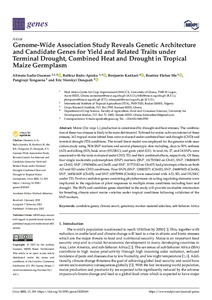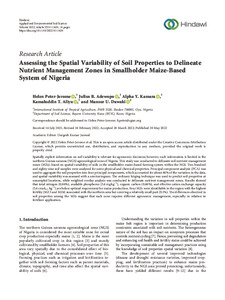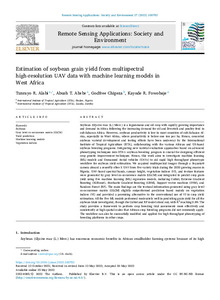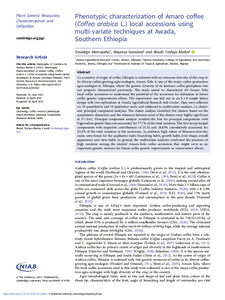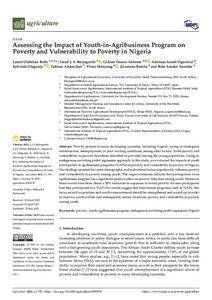Welcome to the International Institute of Tropical Agriculture Research Repository
Journal and Journal Articles: Recent submissions
Now showing items 661-680 of 5157
-
Analyses of genetic diversity and population structure of sesame (Sesamum indicum L.) germplasm collections through seed oil and fatty acid compositions and SSR markers
(2022)Knowledge of the genetic profiles of diverse germplasm collections of sesame using seed oil, fatty acid contents, and molecular markers is a prerequisite to develop market-preferred cultivars with quantity and quality oil. The objective of this study was to determine the genetic diversity and relationships among Ethiopia’s sesame germplasm collections using seed oil content and fatty acid compositions and diagnostic simple sequence repeat (SSR) markers to select genetically complementary and ... -
Understanding the perceptions of secondary school youth toward agricultural careers in Democratic Republic of Congo, Kenya and Nigeria
(2020)Youth are critical participants in the modernization of African agriculture but often their perception of farming is negative. A baseline survey of 1264 students from eight secondary schools in Democratic Republic (DR) of Congo, Kenya and Nigeria was conducted to assess their attitudes toward career pathways to agriculture and agribusiness. KoboToolBox was used to collect data online before compilation and inspection for errors in Microsoft Excel and exportation into STATA for analysis. Findings ... -
Homing in on endogenous badnaviral elements: Development of multiplex PCR-DGGE for detection and rapid identification of badnavirus sequences in yam germplasm
(2022)Viruses of the genus Badnavirus (family Caulimoviridae) are double-stranded DNA-reverse transcribing (dsDNA-RT) plant viruses and have emerged as serious pathogens of tropical and temperate crops globally. Endogenous badnaviral sequences are found integrated in the genomes of several economically important plant species. Infection due to activation of replication-competent integrated copies of the genera Badnavirus, Petuvirus and Cavemovirus has been described. Such endogenous badnaviral elements ... -
Adoption of improved cassava varieties by processors is linked to processing characteristics and products biophysical attributes
(2022)Evidence from community cassava processors on product quality traits that influence variety adoption was combined with laboratory methods to identify potential predictors of quality traits of new varieties. The study revealed that high product yield, high starch content, high solubility index (SI), high peak viscosity (PV), low setback viscosity, and delayed root color change (delayed postharvest physiological deterioration) are possible laboratory indicators that could be used as proxies for ... -
Datasets on the variations of minerals in biofortified cassava (Manihot esculenta Crantz) as a function of storage root portion, maturity and environment
(2022)Background: The accurate measurements of the mineral content of cassava roots are vital from a nutritional perspective. The research datasets were from the study assessing the influence of storage root portion, maturity, and environment on the variations of minerals in biofortified cassava roots. Methods: Twenty-five biofortified clones with three varieties as checks were harvested 12 months after planting from five different environments. Also, a different thirty-nine (39) biofortified cassava ... -
Identification of early and extra-early maturing tropical maize inbred lines with multiple disease resistance for enhanced maize production and productivity in sub-Saharan Africa
(2022)Maize, a staple for millions across sub-Saharan Africa (SSA), faces major biotic constraints affecting production and safety of the crop. These include the northern corn leaf blight (NCLB), southern corn leaf blight (SCLB), Curvularia leaf spot (CLS), and aflatoxin contamination by Exserohilum turcicum, Bipolaris maydis, Curvularia lunata, and Aspergillus flavus, respectively. Farmers in SSA would benefit tremendously if high yielding maize hybrids with multiple disease resistance (MDR) were ... -
Accelerated genetic gains in early-maturing maize hybrids following three periods of genetic enhancement for grain yield under low and high soil-nitrogen environments
(2022)Maize (Zea mays L.) is an important staple, as well as cash crop, in sub-Saharan Africa (SSA). However, its production is severely constrained by low soil nitrogen (low N). Fifty-four early-maturing hybrids developed during three breeding periods, (2008–2010, 2011–2013 and 2014–2016) were evaluated under low (30 kg ha−1) and high (120 kg ha−1) soil nitrogen (N) in Ile-Ife and Mokwa, Nigeria, from 2017 to 2019. The study was designed to (i) determine the genetic gains in grain yield of the ... -
Genome-wide association analysis reveals genetic architecture and candidate genes associated with grain yield and other traits under low soil nitrogen in early-maturing white quality protein maize inbred lines
(2022)Maize production in the savannas of sub-Saharan Africa (SSA) is constrained by the low nitrogen in the soils. The identification of quantitative trait loci (QTL) conferring tolerance to low soil nitrogen (low-N) is crucial for the successful breeding of high-yielding QPM maize genotypes under low-N conditions. The objective of this study was to identify QTLs significantly associated with grain yield and other low-N tolerance-related traits under low-N. The phenotypic data of 140 early-maturing ... -
Aflatoxin and fumonisin mycotoxins contamination along the maize value chain in the eastern Democratic Republic of Congo
(2022-04)Aflatoxin and fumonisin contamination was assessed in different samples along the maize value chain in different territories of South Kivu province. Kabare and Ruzizi Plain were chosen as they represent two different agroecological areas where maize is mostly produced. Twelve districts and one town were selected across the province. The stakeholders were randomly selected, and 215 maize (139 maize grain and 76 maize flour) samples were taken for laboratory analysis. The Q + kit was used to determine ... -
Grain yield potential and stability of soybean genotypes of different ages across diverse environments in southern Africa
(2022)Soybean [Glycine max (L.) Merrill] is an important crop in southern Africa where it is cultivated in a wide range of agro-ecologies. Both spatial and seasonal variability is high in the region. As a result, breeders aim to release varieties with a fine balance of high productivity potential and stability. Genotype × environment interaction (GEI) limits the selection of superior genotypes in heterogeneous environments consequently slowing down breeding progress. This study determined the magnitude ... -
Phylogeography and conservation gaps of Musa balbisiana Colla genetic diversity revealed by microsatellite markers
(2022)Collection and storage of crop wild relative (CWR) germplasm is crucial for preserving species genetic diversity and crop improvement. Nevertheless, much of the genetic variation of CWRs is absent in ex situ collections and detailed passport data are often lacking. Here, we focussed on Musa balbisiana, one of the two main progenitor species of many banana cultivars. We investigated the genetic structure of M. balbisiana across its distribution range using microsatellite markers. Accessions stored ... -
Contribution of temperate germplasm to the performance of maize hybrids under stress and non-stress environments in South Africa
(2022)Increases in genetic gains are crucial to maize breeding programmes. The objectives of this study were to identify higher-yielding and stable maize hybrids across stress and non-stress environments, to identify representative test environments for testing and selection of superior maize genotypes, and to determine the contribution of temperate maize germplasm in the performance of new tropical hybrids. Respectively 42 and 72 newly developed single-cross hybrids together with check hybrids were ... -
Genetic diversity and population structure of an African yam bean (Sphenostylis stenocarpa) collection from IITA GenBank
(2022-03)African yam bean, AYB (Sphenostylis stenocarpa), is an underutilized legume of tropical Africa. AYB can boost food and nutritional security in sub-Saharan Africa through its nutrient-rich seeds and tubers. However, inadequate information on germplasm with desirable agro-morphological traits, including insufficient data at the genomic level, has prevented the full exploitation of its food and breeding potentials. Notably, assessing the genetic diversity and population structure in a species is a ... -
Coupled forest zoning and agricultural intervention yields conflicting outcomes for tropical forest conservation in the Democratic Republic of the Congo (DRC)
(2022)Agricultural intensification and forest conservation are often seen as incompatible. Agricultural interventions can help boost food security for poor rural communities but in certain cases can exacerbate deforestation, known as the rebound effect. We tested whether coupling agricultural interventions with participatory forest zoning could improve food security and promote forest conservation in the Democratic Republic of the Congo. Simple agricultural interventions led to a >60% increase in cassava ... -
Genome-wide association study reveals genetic architecture and candidate genes for yield and related traits under terminal drought, combined heat and drought in tropical maize germplasm
(2022)Maize (Zea mays L.) production is constrained by drought and heat stresses. The combination of these two stresses is likely to be more detrimental. To breed for maize cultivars tolerant of these stresses, 162 tropical maize inbred lines were evaluated under combined heat and drought (CHD) and terminal drought (TD) conditions. The mixed linear model was employed for the genome-wide association study using 7834 SNP markers and several phenotypic data including, days to 50% anthesis (AD) and silking ... -
Assessing the spatial variability of soil properties to delineate nutrient management zones in smallholder maize-based system of Nigeria
(2022)Spatially explicit information on soil variability is relevant for agronomic decisions; however, such information is limited in the northern Guinea savanna (NGS) agroecological zone of Nigeria. This study was conducted to delineate soil nutrient management zones (MZs), based on spatial variability of soils in the smallholder maize-based farming system within the NGS. Two hundred and eighty-nine soil samples were analyzed for some physical and chemical properties. Principal component analysis (PCA) ... -
Interaction of varieties and fungicides across seasons and locations for the control of Asian soybean rust (Phakopsora pachyrhizi) in southwestern Ethiopia
(2022-08)Soybean is emerging as an important legume and oil crop in Ethiopia. However, the crop has been facing serious threats from Asian Soybean Rust (ASR), causing significant damage to the crop and not allowing it to realize its potential. This study aimed to determine the interaction of three varieties with various fungicide treatments across two seasons and two locations to manage ASR. The experiment was laid out in a RCBD in a factorial [three soybean varieties (V) and six fungicides (F)] treatment ... -
Estimation of soybean grain yield from multispectral high-resolution UAV data with machine learning models in west Africa
(2022-08)Soybean (Glycine max (L.) Merr.) is a leguminous and oil crop with rapidly growing importance and demand in Africa following the increasing demand for oil and livestock and poultry feed in sub-Saharan Africa. However, soybean productivity is low in most countries of sub-Saharan Africa, especially in West Africa, where productivity is below one ton per ha. Hence, concerted soybean varietal development and testing efforts have been underway by the International Institute of Tropical Agriculture ... -
Phenotypic characterization of Amaro coffee (Coffea arabica L.) local accessions using multi-variate techniques at Awada, southern Ethiopia
(2022)As a country of origin of coffee, Ethiopia is endowed with an immense diversity of the crop in its diverse coffee-growing agro-ecologies. Amaro Kelo is one of the major coffee production agro-ecologies in Ethiopia, where the genetic diversity of its landrace coffee germplasm was not properly characterized previously. The study aimed to characterize 64 Amaro Kelo local coffee accessions to understand the potential of the accessions for utilization in future coffee genetic improvement efforts. The ... -
Assessing the impact of Youth-in-Agribusiness Program on poverty and vulnerability to poverty in Nigeria
(2022)Poverty persists in many developing countries, including Nigeria, owing to inadequate infrastructure, unemployment, or poor working conditions, among other factors. Youth poverty and vulnerability to poverty have been identified to prevalent among the young population. Using an endogenous switching probit regression approach, in this study, we evaluated the impacts of youth participation in agribusiness programs (YIAPs) on poverty and vulnerability to poverty in Nigeria. Our findings revealed that ...



